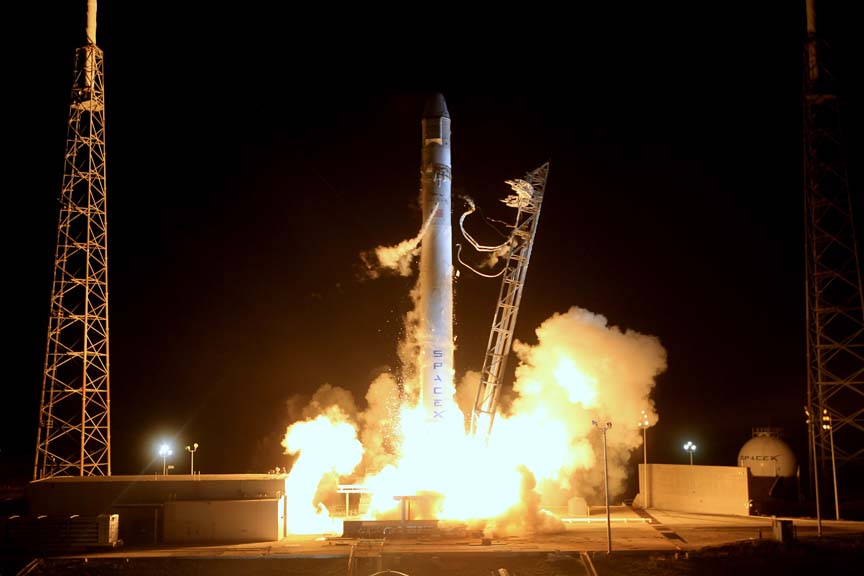While threats to American defense satellites were climbing sharply, the costs and schedules of U.S. military space programs were on the same unsustainable trajectory — prompting lawmakers last year to begin trying to reorganize Air Force’s military space programs by creating a Space Corps. A move that, so far, has failed.
Having narrowly avoided having its future set by others, the Space and Missile Systems Center (SMC) began earnestly remodeling its acquisition practices at the beginning of 2018. The changes at SMC, however, may now be absorbed into a more expansive effort by the Trump Administration to consolidate and elevate military space activities. The White House used a congressionally mandated Department of Defense (DOD) study to detail a plan to immediately start amalgamating space activities as a prelude to the creation of a new department of the military — a Space Force on par with the Air Force itself.
“It is a striking acceleration of the process and reflects, I think to a certain extent, surprising alignment between the White House, Pentagon and Congress on the path forward,” said Mike Tierney, who follows space policy closely as a senior consultant and budget expert with the defense, space/intelligence, homeland security consulting firm Jacques & Associates. “The White House has said that this is a priority. The Pentagon’s report sets in motion many steps to that end (and) aligns a lot with what the Hill has been pushing all along. So to a certain extent the outcome is surprising — that it’s less conflict driven — and the optics seem to be on a relatively steady path forward towards implementation.”
Making It Happen
The ball is now in the court of Congress, which will have to approve and fund the creation of this new service. That seems likely — given the backing of Trump, who reportedly sees the Space Force as an energizing issue for his base — and the congressional support that already exists, at least in the House.
Rep. Mike Rogers, R-Alabama, the vocal chairman of the House Armed Services Subcommittee on Strategic Forces, has already pledged to introduce a bill in January to give the Pentagon the authority it needs to create a Space Force. Rogers and his subcommittee’s ranking member Jim Cooper, D-Tennessee, launched the Space Corps proposal last year after learning about the rising space capabilities of adversarial nations.
“It was jarring to our committee a little over a year ago to have (General) John Hyten come in and tell us that China was our — if not our near peer, our peer in space, and Russia our near peer, and then have Admiral (Cecil) Haney tell us at PACOM (U.S. Pacific Command) not long after that: ‘No. They’re both our peers now.’ That’s unacceptable that we have allowed that to happen, particularly in a day and age when it is essential to have those space capabilities to fight and win wars,” Rogers said during CSIS panel on National Security Space earlier this year in Washington.
“The disappointing thing,” Rogers told the audience, “is that the more we looked at it, the more we became convinced that it can’t be fixed within the Air Force, the way it is structured now.”
Rogers and Cooper pushed hard to establish a Space Corps within the Air Force but had to settle for a pair of studies on the matter.
“Our Senate friends, in our opinion, were not as alert to the need for birthing a Space Corps as we were, but hopefully that will be corrected in a coming session,” Rogers told the CSIS audience in February.
One of those studies, by the Center for Naval Analyses — a federally funded research and development center chosen, in part, because it is fully independent from the Air Force — is due at the end of the year.
The other study, the Final Report on Organizational and Management Structure for the National Security Space Components, was released August 9. It blows past the debate over a Space Corps within the Air Force to sketch out the steps the DOD plans to take immediately, with the authority it already has, to reorganize military space management as a prelude to creating a U.S. Space Force.
Space Force Part 1
During this initial phase DOD intends to establish four organizations that ultimately, with future congressional approval, would be combined into the new military department.
1) Space Development Agency — This group will be tasked with developing and fielding space capabilities “at speed and scale.” SMC, which manages the GPS Directorate, will likely become part of this agency. Moreover the Pentagon says it intends to make this a joint agency that encompasses all the services. More on this later.
2) Space Operations Force — The Operations Force will be the focal point for identifying, training and supporting space personnel and providing them the fulsome advancement opportunities that have generally been lacking for the DOD’s space personnel. People will be drawn from all the services, the National Guard and from among civilians. They will stay in their current services until the Space Force is formed but, similar to Special Operations Forces, will be “developed and managed as one community.” Over the time the Space Operations Force is expected to grow to “support continuous rotational presence at combatant commands” whose support is the Space Force’s main mission.
3) Services and Support — The DOD, with legislative help from Congress, will create the governance, services, and support functions needed by the Space Force. The DOD will craft a legislative proposal for lawmakers to consider as a part of the fiscal year 2020 budget cycle.
4) Space Command — This organization, to be commanded by a four-star general or flag officer, will lead the use of space assets in warfighting operations to protect U.S. national interests. It will also work to accelerate integration of space capabilities into other warfighting forces.
The four organizations will be stood up quickly to meet a high priority goal, Deputy Secretary of Defense Patrick Shanahan told reporters August 9 — accelerating space technology while anchoring development initiatives to the modernization priorities outlined in the National Defense Strategy.
“Space Force is about concentrating resources so we can go faster, “ Shanahan said.
But what about the program offices — including the GPS Directorate, which runs the GPS program? What about Space and Missile Center (SMC), which manages the Directorate?
“It’s still going to be there,” Shanahan told reporters.
SMC 2.0
It’s reasonable to wonder. SMC is both a nexus of Air Force space activities and in the midst of a broad reorganization.
SMC Commander Lt. Gen. John F. Thompson launched the major overhaul called SMC 2.0 in January with the goal of removing the hurdles that were making SMC — according to a survey of its own 5,000 staff members — slow and bureaucratic.
Thompson told a June seminar on Space Power to the Warfighter held by the Mitchell Institute for Aerospace Studies that he’d already pushed decision-making authority down the chain and closer to the action to speed things up.
“So 40 percent of my ACAT (Acquisition Category) programs are now being handled by my program directors, not at the PEO (Program Executive Officer) level,” Thompson said. “That’s requirements-approving officials, that’s milestone decision authorities — those are the folks that are running the programs. A lot of our service category programs which aren’t technically ACAT programs, less than $100 million, we have delegated down to the program directors so that they can manage them themselves.”
One of the next steps, as of June, was to create four agency-wide groups within SMC — the Development, Production, Enterprise and Atlas Corps — to both find and support synergies in the organization’s currently stove piped structure. There might be a satellite bus, for example, that could be used for more than one program if people only knew about it.
The Development Corps will deal with pre-milestone C programs within the organization and will be “making decisions about them day in and day out, connecting the dots, again, across the enterprise,” said Thompson. “When a program is ready to transition into full production, a real program of record, then that Development Corps will pass off the decision-making for that program and pass off the team that’s doing it to something called a Production Corps.”
The Atlas Corps will be there for management tasks like cost estimates and independent reviews. The Enterprise Corps will handle system-related elements like launch, testing and cybersecurity. They will likely be working with the recently renamed and beefed up Space Rapid Capabilities Office or Space RCO (formerly named the Operationally Responsive Space Office). Though the RCO is not part of SMC it will be connected because it will be sharing ground control segments and launches.
This setup is quite different from the changes being discussed earlier this year, according to sources. At one point there was no Atlas Corps and the program offices were going to disappear with all the programs being handled by the different corps based on where they were in their production cycle.
One consistent element, however, has been the creation of a Portfolio Architect, a small team of 150 to 200 people, who will work across programs to find those synergies. Thompson said the architect’s office would include a chief innovation officer and a chief partnership officer who will “connect the dots for us across our enterprise.” If the role of the chief partnership officer is as earlier envisioned, it could become a single point of contact with SMC. Firms with new ideas, for example, would not have to pitch to each individual program office but could have a conversation that applies to the SMC as a whole.
Timeline
Thompson said that he didn’t envision any large, near term changes in the program offices or for SMC’s support contractors — though the contractors may find new opportunities emerging over time, especially with the Space RCO.
“I envision most of the folks at SMC to stay in their traditional two letter programs,” said Thompson, “just reporting to different decision-making entities where there’s good coordination as enabled by the portfolio architect.”
In the longer term, however, SMC may find its role split as the Space Force takes shape. Shanahan said that he did not expect SMC to evolve into the Space Force but that elements of SMC would likely be carved out for the new branch.
“That means we’re going to take resources that exist in the SMC — I think we’re going to take resources from other parts of the department — and put those together,” Shanahan said.
But just what is “longer term”? Rogers told the CSIS audience that it would likely take three to five years to set up a Space Corps, and that was a simpler process. The Space Force effort could be further complicated should the administration want to incorporate elements from other services.
Rogers said he had focused on changes within the Air Force, which handles the vast majority of DOD’s space effort, because “we didn’t want any more political pushback than we were going to get already.” He had spoken with the Navy about moving the Mobile User Objective System (MUOS) and did not foresee a lot of issues, he said. “While the Navy wasn’t going to be a problem. I don’t know, the Army might have been. And I can guarantee the IC (intelligence community) would have been if we had messed with the NRO (National Reconnaissance Office).”
“Congress will likely hold some more hearings this fall to think about what are the potential options for reorganization,” said Todd Harrison, director of the Aerospace Security Project at think tank CSIS. “How do you do it? An important question is what’s the scope of the Space Force? Clearly it’s going to include all of Air Force Space Command but what parts of the Navy and the Army would be included in it as well? And are they going to bring in parts of the intelligence community? Those are open questions. And also, are there going to be parts of missile defense that get pulled into this because some of our missile defense capabilities overlap with space capabilities.”
In addition there is potential for push back from the space industry, which has substantial infrastructure centered around SMC in Los Angeles.
“There is some concern for the L.A. Air Force Base/SMC Air Force existing equities,” said a source who spoke on background to be able discuss the matter freely. “There is some chatter that SMC and Los Angeles Air Force Base may not retain the Space Missile Center mission as part of the Air Force. If a new military department is stood that has a new acquisition corps then there is a feeling that that very well could mean that every one at SMC would go somewhere else to operate the new military department’s acquisition corps for space programs. That could have a major political impact to Los Angeles and the Air Force Base.”
Implications
Though there is political momentum behind a Space Force it will take time to put into place and it could easily get derailed. Should the House or Senate change hands the stage will be set for confrontation between lawmakers and the White House on a host of issues and legislation setting up a Space Force could get squeezed out. That would leave the SMC 2.0 changes, which are already being implemented, as the reorganizational default.
But it’s unlikely that the push for a new space organization will disappear. Bipartisan allies Rogers and Cooper are in safe seats this election cycle and the need to keep space programs on time and on budget is a very high-profile problem.
Whatever happens there are already implications for the GPS program beyond an unsettled reporting structure.
As mentioned keeping modernization on track, and that should certainly include GPS modernization, is a top priority of the Defense Department. The DOD also made it clear in the Space Force report that an “alternate positioning, navigation, and timing (PNT) for a GPS-denied environment” was a priority. Space Force or no Space Force, that effort could move ahead.
SMC’s Thompson and the DOD’s Shanahan also foresaw a broader horizontal integration of infrastructure — including, in particular, satellite ground stations. That could impact the still developing GPS next-generation operational control system (GPS OCX). Its cybersecurity element could even become a standard for other systems.
“If we were going to harmonize the infrastructure across the department,” said Shanahan, “having a horizontal integration approach to infrastructure, ground station(s) — pick the piece of important critical infrastructure. It’s very important that we have standards and that we’re able to scale that infrastructure.”
“We’re going to work on an enterprise ground solution,” Thompson told the Mitchell Institute audience. “There is absolutely no reason why every satellite has to have its own ground control segment. We have got to figure out how to plug our satellites into common ground segments, and enterprise ground services is the way to do that.”






